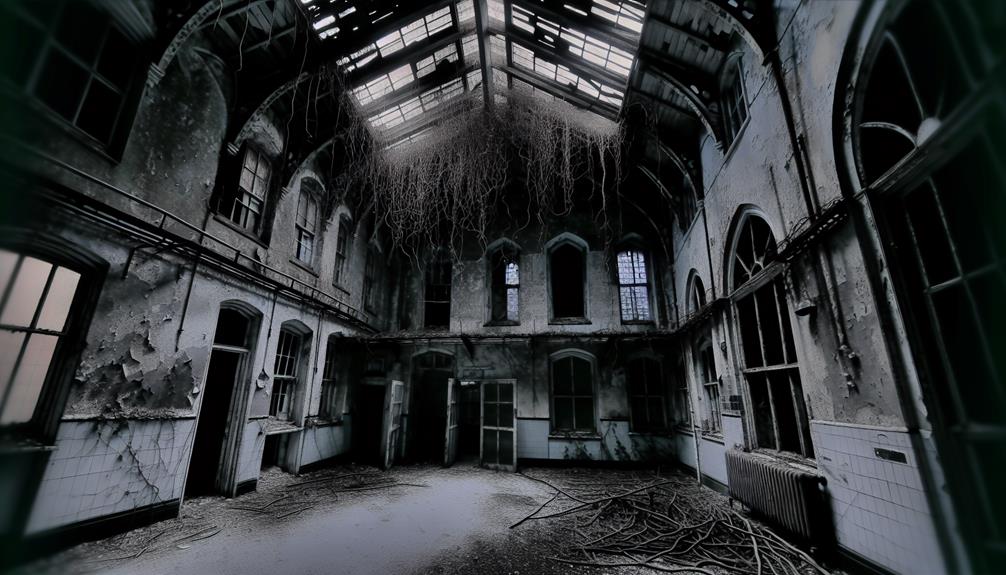Immersing oneself in the history of Sachsenhausen provides a chilling glimpse into the dark abyss of Nazi atrocities during World War II. The stark reality of the camp's existence serves as a haunting reminder of the depths of human cruelty and the capacity for inhumanity. As we explore the depths of Sachsenhausen's past, we begin to unravel the layers of horror that unfolded within its confines, shedding light on a chapter in history that demands reflection and remembrance. The somber echoes of Sachsenhausen beckon us to confront the shadows of the past and ponder the weight of its enduring legacy.
Key Takeaways
- Sachsenhausen was a model Nazi concentration camp, established in 1936 to enforce Nazi ideology.
- Inmates endured harsh living conditions, inadequate food, and back-breaking labor in Sachsenhausen.
- The camp was a site of brutal Nazi experiments, including forced sterilizations and medical tests.
- Post-liberation, survivors faced psychological challenges and the need for healing and reconciliation.
- Memorial sites serve to remember the victims, educate about atrocities, and foster reflection and unity.
The Rise of Sachsenhausen
The establishment of Sachsenhausen concentration camp in 1936 marked a significant escalation in the Nazi regime's systematic persecution and imprisonment of political opponents, Jews, and other targeted groups in Germany. Sachsenhausen was one of the first concentration camps established by the Nazis, serving as a model for other camps that followed. Initially constructed to detain political prisoners, the camp's purpose expanded over time to include individuals deemed racially or biologically inferior by the regime, such as Jews, homosexuals, and Romani people.
The origins of Sachsenhausen can be traced back to Heinrich Himmler, the head of the SS, who envisioned the camp as a key instrument for enforcing Nazi ideology and maintaining control over perceived enemies of the state. Situated just north of Berlin, Sachsenhausen's strategic location facilitated easy access for the Gestapo to transport prisoners from the capital and other regions across Germany.
As the Nazi regime tightened its grip on power, Sachsenhausen underwent significant expansion to accommodate the growing number of inmates. New barracks, watchtowers, and perimeter fencing were added to the camp, enhancing its capacity for mass incarceration. The expansion of Sachsenhausen reflected the regime's increasingly ruthless tactics in suppressing dissent and eliminating those deemed undesirable by the Nazis.
Life Inside the Concentration Camp
Life within Sachsenhausen concentration camp was characterized by harsh living conditions, strict regulations, and constant fear of punishment under the oppressive Nazi regime. Prisoners faced overcrowded barracks, inadequate food rations, and back-breaking labor. The daily struggles of inmates centered around trying to survive the brutal conditions imposed upon them.
Survival stories from Sachsenhausen are harrowing. Prisoners had to navigate a system designed to dehumanize and break their spirits. Many resorted to forming alliances with fellow inmates to increase their chances of survival. These alliances provided a sense of camaraderie and support in the face of extreme adversity. Despite the constant fear and suffering, acts of kindness and solidarity among prisoners were not uncommon, serving as a glimmer of humanity in an otherwise dark environment.
The harsh living conditions in Sachsenhausen took a toll on the physical and mental well-being of inmates. Disease, malnutrition, and exhaustion were rampant, contributing to a high mortality rate within the camp. The constant threat of punishment for the slightest infraction instilled a pervasive atmosphere of fear and anxiety among the prisoners.
Nazi Experiments and Brutality
Numerous instances of horrific experimentation and brutal treatment inflicted upon prisoners by the Nazi regime have been documented, revealing the depths of inhumanity perpetrated within the confines of various camps and facilities. The following list provides a glimpse into the medical research and ethical boundaries crossed during this dark period:
- Human Experimentation: Prisoners, regarded as expendable by the Nazis, were subjected to unimaginable medical experiments. These included testing the limits of the human body's endurance to extreme conditions such as hypothermia or high-altitude pressures, often resulting in excruciating pain and death.
- Sterilization Programs: In the pursuit of creating a 'pure' Aryan race, forced sterilizations were conducted on prisoners deemed unworthy of reproduction. This abhorrent practice violated all medical ethics and led to long-lasting physical and psychological trauma.
- Torturous Procedures: Victims were subjected to surgeries without anesthesia, amputations, and other invasive procedures in unsanitary conditions. The suffering inflicted on these individuals for the sake of pseudo-scientific research remains a stain on the history of medicine.
- Psychological Experiments: Unethical studies on the effects of psychological trauma were conducted, pushing individuals to their breaking points. These experiments explored the darkest aspects of human behavior, disregarding the fundamental principles of ethical research.
The atrocities committed in the name of medical research during the Nazi era serve as a stark reminder of the importance of upholding ethical boundaries and preserving the dignity of all individuals.
Liberation and Aftermath
Following the harrowing period of Nazi experiments and brutality, the liberation of prisoners from the camps marked the beginning of a complex and challenging aftermath that would shape the post-war landscape in Germany. The immediate task post-liberation was the challenging challenge of rebuilding communities that had been torn apart by the atrocities committed within the walls of places like Sachsenhausen. The physical and psychological trauma experienced by survivors posed significant obstacles to this rebuilding process.
The survivors of the camps faced profound psychological challenges in the aftermath of their liberation. Many suffered from severe trauma due to the inhumane treatment they endured during their internment. The psychological scars left by the horrors of the camps would have long-lasting effects on the survivors, impacting their ability to reintegrate into society and rebuild their lives. Addressing and healing this psychological trauma became an important aspect of the post-liberation period.
Rebuilding communities also meant addressing the broader societal impact of the camps. The atrocities committed under the Nazi regime had left a deep scar on German society as a whole. Coming to terms with this dark chapter in history and rebuilding a sense of national identity that acknowledged and learned from these atrocities was essential for Germany to move forward. The liberation of the camps was just the beginning of a long and challenging process of healing and reconciliation for both the survivors and the nation as a whole.
Remembering the Victims
In commemorating the victims of Nazi atrocities in Germany, it is essential to establish memorial sites that serve as poignant reminders of the horrors endured during this dark period of history. Honoring victims through these memorials allows for historical reflection, ensuring that the atrocities committed are never forgotten. Here are four key ways in which these memorial sites play an important role:
- Preserving the Memory:
Memorial sites such as Sachsenhausen serve as tangible reminders of the individuals who suffered and perished during the Nazi regime. Through exhibits, artifacts, and educational programs, the memory of the victims is kept alive for present and future generations.
- Educational Purposes:
These sites offer educational opportunities for visitors to learn about the atrocities committed, fostering a deeper understanding of the impact of hatred and discrimination. By engaging with the historical context, individuals can reflect on the consequences of intolerance.
- Promoting Empathy and Compassion:
By immersing visitors in the stories of the victims, memorial sites evoke feelings of empathy and compassion. This emotional connection encourages visitors to stand against injustice and to promote a more inclusive and accepting society.
- Fostering Healing and Unity:
Memorial sites provide spaces for reflection and contemplation, allowing visitors to pay their respects to the victims. This collective act of remembrance fosters a sense of unity and solidarity, emphasizing the importance of standing together against oppression and prejudice.
Frequently Asked Questions
How Were Prisoners Selected for Sachsenhausen?
The selection process at Sachsenhausen involved categorizing prisoners based on perceived threats to the Nazi regime. Various prisoner categories were established, including political opponents, Jews, homosexuals, and other marginalized groups.
These individuals were subjected to brutal conditions, forced labor, and often faced extermination. The selection process was a tool used by the Nazis to maintain control and instill fear among those deemed undesirable by the regime.
What Was the Daily Routine Like for Inmates?
The daily routine for inmates at Sachsenhausen was marked by extreme hardship and dehumanization. Inmate conditions were harsh, with long hours of forced labor, minimal food rations, and constant physical and psychological abuse.
Prisoner treatment was cruel and calculated to break the spirit of those held captive. Despite the grueling conditions, inmates often found ways to support each other and maintain a sense of solidarity in the face of adversity.
Were There Any Escape Attempts From Sachsenhausen?
Escape attempts and prisoner resistance were common occurrences at Sachsenhausen. Despite the high security measures in place, inmates devised various strategies to flee the camp.
From creating fake uniforms to digging tunnels, the prisoners exhibited remarkable courage and determination in their escape efforts. However, the harsh consequences for failed attempts, including severe punishment or execution, served as a deterrent for many contemplating breakouts.
How Did the Nazis Justify Their Brutal Experiments?
The Nazis justified their brutal experiments by exploiting twisted ethical concerns and falsely claiming to pursue medical advancements. Under the guise of scientific progress, they dehumanized victims and disregarded basic human rights.
How Did Survivors Cope With Their Experiences After Liberation?
Survivors of Nazi atrocities coped with their experiences after liberation through various means. Many faced post-traumatic stress disorder, requiring psychological healing.
Support from fellow survivors, counseling services, and advocacy groups played pivotal roles in their recovery. Engaging in artistic expression, storytelling, and community activities also aided in processing trauma.
Despite the immense challenges, survivors demonstrated resilience and strength in rebuilding their lives and finding a sense of belonging after such harrowing experiences.
Conclusion
To sum up, the history of Sachsenhausen concentration camp serves as a stark reminder of the atrocities committed during the Nazi regime in Germany.
One interesting statistic is that over 200,000 prisoners were held at Sachsenhausen between 1936 and 1945, with thousands perishing due to the brutal conditions and inhumane treatment.
This statistic highlights the scale of suffering and serves as a poignant reminder of the importance of remembering and honoring the victims of Nazi atrocities.


